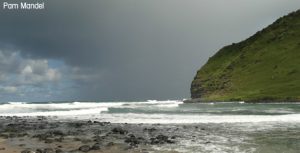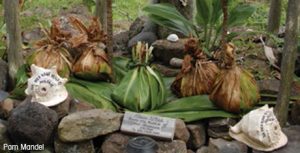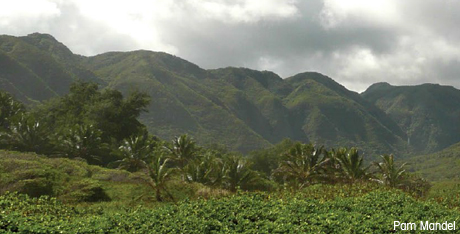We were stopped in the middle of a narrow, winding road by a vehicle coming the other way. The big guy behind the wheel rolled down his window. “Are you Pam?” he asked. “I have to drop my cousin off at school; I’ll be back as soon as I can. Head down to the end of the road, OK? The beach is there. Hang out. I’ll be along soon.”
West Moloka’l. Calling it West Moloka’l makes it sound like I’d traveled some distance, but I’d been in the car for only half an hour. Maybe longer, because I’d stopped frequently to take pictures and once to buy some snacks. The guy driving the pickup truck on the uphill side of the road was Lawrence Kalainia Kamani Aki. Not long after we’d crossed paths on the road, he returned to the sandy parking lot.
It’s easier for everyone to keep it private.
He was a tough-looking guy in board shorts and a T-shirt, but he had a big, easy smile. “I’ve heard about you …” I started, and he told me, yeah, he’s that guy. He’s the one who scowls at trespassers, the one who gives grief to visitors who ignore the “kapu” signs that dot the inland side of the road.
He explains it a bit further. It’s not so much that they don’t want to share this beautiful place, it’s that if someone gets lost or injured on the rocky trail, they’re responsible. It’s easier for everyone to keep it private and to guide guests; that way there’s no drama and everyone treats the place with respect.
“Well, thanks for having me. I’m happy to be here,” I say. Everything changes in his face in that moment, and he smiles, big.
 Halawa is a private place, not a city park. It’s kalo (tarot) patches farmed by Native Hawaiians for generations. It’s a little watercourse that runs from the waterfall. It’s stones with stories. To gain access, Julie-Anne Bicoy, head of the island’s tiny tourism department, formally introduces us to Lawrence. Lawrence then leads us up the trail, past all the no trespassing signs, where we meet Anakala Pilipo Solatorio, the elder of this land.
Halawa is a private place, not a city park. It’s kalo (tarot) patches farmed by Native Hawaiians for generations. It’s a little watercourse that runs from the waterfall. It’s stones with stories. To gain access, Julie-Anne Bicoy, head of the island’s tiny tourism department, formally introduces us to Lawrence. Lawrence then leads us up the trail, past all the no trespassing signs, where we meet Anakala Pilipo Solatorio, the elder of this land.
We’re just a little group, five total: Julie; a plumber and his wife from Queens via Poland; a sad-eyed man from California; and me. We fall into an easy camaraderie, but before we take one step across the property line into the Halawa Valley, we must perform protocol. We must ask for permission to cross onto this sacred land. We stop our fellow travelers’ chatter and focus on our local hosts as they tell us what is about to happen.
If I had a chant, I would sing out my history.
It’s complicated. First, Lawrence blows a conch shell; the sound fills the heavy air and sends the message, “Hey, we’re here! We want you to know that we’re here!” There’s a response, and the chants begin. If I had a chant, I would sing out my history. I would tell the keepers of this river valley about where I’m from; I want to see the falls and learn their story. Then, the response — in Hawaiian: “Yes, welcome; we are here, and you may visit us. You are welcome!” The words change for every place, but the meaning is essentially the same.
 Julie hands me a big green coconut, and I pass it along to Anakala, the elder. It’s really the thought that counts because coconuts are, of course, as plentiful as, well, coconuts here. It’s the act of presenting a gift that matters. “I brought you this gift in thanks for your permission to visit your place.” Anakala takes the coconut and places it on a little trailside altar with the desiccated leaves of leis and fading flowers offered by other visitors.
Julie hands me a big green coconut, and I pass it along to Anakala, the elder. It’s really the thought that counts because coconuts are, of course, as plentiful as, well, coconuts here. It’s the act of presenting a gift that matters. “I brought you this gift in thanks for your permission to visit your place.” Anakala takes the coconut and places it on a little trailside altar with the desiccated leaves of leis and fading flowers offered by other visitors.
Then, I stand toe to toe with the storyteller, the teacher, the elder, and he presses his forehead to mine, the bridge of his nose to mine. We take a deep breath, eyes wide open. It feels like a long time. Everything collapses into the moment, and I think about what I am doing here. What are my intentions in this place? What do I carry with me? What will I take away?
The beach here is a scoop of black sand lined with velvet green cliffs.
It is almost too personal, this greeting, and I close my eyes to regain my composure. When I open them again, the moment has passed. The rest of our group greets Anakala the same way, and then, we’re on our way, hiking up the dusty trail, picking our way through the lava rocks, learning the names of the vines and trees and waters that come from up high.
At the end of the day I return to the little parking lot at the end of the road. The beach here is a scoop of black sand lined with velvet green cliffs. Julie and I are the only ones left. I carry my shoes and pick my way down to the surf. Julie laughs at me. “You’ve gone local!” she says and snaps my picture.
Sometimes I imagine coming back to Halawa, of asking to visit again in my own language, in my own way. “I don’t expect you to remember my visit,” I would sing up the trail. “But this place seems to be a part of me now. I have brought you coffee, or ti leaves, or this coconut that is shiny and green. And if you will allow it, I would like to once again stand in the waterfall and feel the cool air of this beautiful place.”
I have forgotten the names of the trees, and I only vaguely remember the story about the mythical lizard of the waterfall. But I remember exactly what to do in order to visit again. I must ask.



